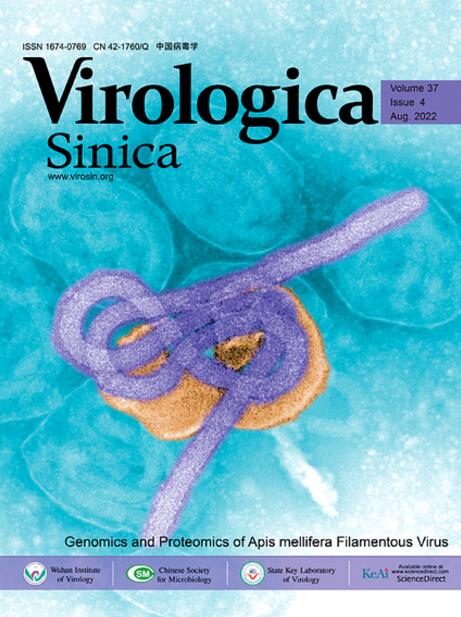Phylogenetic analyses and antigenic characterization of foot-and-mouth disease virus PanAsia lineage circulating in China between 1999 and 2023
IF 5.5
3区 医学
Q1 Medicine
引用次数: 0
Abstract
Foot-and-mouth disease (FMD) is one of the most important transboundary animal diseases caused by foot-and-mouth disease virus (FMDV), leading to significant economic losses worldwide. The first report of PanAsia lineage of FMDV in China was in 1999. Since 2011, 18 outbreaks attributed to PanAsia lineage viruses have been reported across 7 provinces or municipality in China. Phylogenetic analysis indicated that these PanAsia strains were clustered into three distinct clades (clade 1, clade 2, and clade 3), with nucleotide homology ranging from 91.4% to 100%. The outbreaks of FMD caused by clade 1 strains occurred around 1999 when this lineage was prevalent globally. Clade 2 strains dominated from 2011 to 2013, while clade 3 strains were prevalent during 2018–2019, sharing only 93% homology with clade 2 strains and 91% with clade 1 strains. Tracing analysis showed that these outbreaks represented 3 distinct introductions of PanAsia viruses into China. Virus neutralization tests (VNT) have demonstrated that current commercial vaccines are effective to protect susceptible animals against these strains (r1 > 0.3). However, the growing demand for livestock has promoted animal movement and encouraged the exchange of products, services, and materials between countries, thereby heightening the risk of exotic strain incursions. Therefore, it is imperative to reinforce border controls and limit animal movements among various Asian countries continually to reduce the risk of new transboundary diseases, such as FMD incursion. Additionally, PanAsia-2 strains need to be taken seriously to prevent its incursions, and the relevant vaccines against PanAsia-2 strains need to be stockpiled in preparation for any possible incursion.
1999年至2023年期间在中国流行的口蹄疫病毒泛亚系的系统发育分析和抗原特征。
口蹄疫(FMD)是由口蹄疫病毒(FMDV)引起的最重要的跨境动物疫病之一,在全球范围内造成重大经济损失。中国于 1999 年首次报告泛亚系口蹄疫病毒。自 2011 年以来,中国 7 个省市共报告了 18 起泛亚系口蹄疫病毒疫情。系统发生学分析表明,这些泛亚系毒株分为三个不同的支系(支系1、支系2和支系3),核苷酸同源性为91.4%至100%。由支系 1 菌株引起的口蹄疫爆发发生在 1999 年前后,当时该支系在全球流行。2011年至2013年期间,支系2菌株占主导地位,而支系3菌株在2018年至2019年期间流行,与支系2菌株的同源性仅为93%,与支系1菌株的同源性为91%。溯源分析表明,这些疫情代表了泛亚病毒在中国的3次不同传入。病毒中和试验(VNT)表明,目前的商业疫苗可有效保护易感动物免受这些毒株的感染(r1 > 0.3)。然而,对牲畜日益增长的需求促进了动物的流动,鼓励了国家间产品、服务和物资的交换,从而增加了外来毒株入侵的风险。因此,当务之急是加强边境管制,限制亚洲各国之间的动物流动,以降低新的跨境疾病(如口蹄疫)入侵的风险。此外,需要认真对待泛亚 2 号毒株,以防止其入侵,并需要储备针对泛亚 2 号毒株的相关疫苗,为任何可能的入侵做好准备。
本文章由计算机程序翻译,如有差异,请以英文原文为准。
求助全文
约1分钟内获得全文
求助全文
来源期刊

Virologica Sinica
Biochemistry, Genetics and Molecular Biology-Molecular Medicine
CiteScore
7.70
自引率
1.80%
发文量
3149
期刊介绍:
Virologica Sinica is an international journal which aims at presenting the cutting-edge research on viruses all over the world. The journal publishes peer-reviewed original research articles, reviews, and letters to the editor, to encompass the latest developments in all branches of virology, including research on animal, plant and microbe viruses. The journal welcomes articles on virus discovery and characterization, viral epidemiology, viral pathogenesis, virus-host interaction, vaccine development, antiviral agents and therapies, and virus related bio-techniques. Virologica Sinica, the official journal of Chinese Society for Microbiology, will serve as a platform for the communication and exchange of academic information and ideas in an international context.
Electronic ISSN: 1995-820X; Print ISSN: 1674-0769
 求助内容:
求助内容: 应助结果提醒方式:
应助结果提醒方式:


